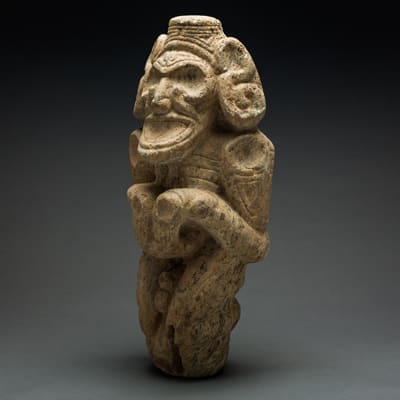Taino Stone Zemi Sculpture, 1000 CE - 1500 CE
Stone
51.1 x 22.9 cm
20 1/8 x 9 in
20 1/8 x 9 in
CC.522
Further images
Carved from a pale flecked green/brown stone, this sculpture represents a Taino zemi- the physical manifestation of a god, spirit or ancestor. The Taino were polytheistic and worshipped a creator...
Carved from a pale flecked green/brown stone, this sculpture represents a Taino zemi- the physical manifestation of a god, spirit or ancestor. The Taino were polytheistic and worshipped a creator deity, Yucahu Maorocoti, and a fertility goddess called Attabeira. Beneath these supreme deities were a host of lesser gods, including former Taino chieftains (caciques) and shamans that had been deified after their deaths. Ancestor worship was a central part of the Taino religious system and helped to bolster the political and moral authority of the chieftains. According to Spanish chroniclers, the bones of high status individuals were carefully stored in wooden urns or hung from the rafters of houses. This belief in the talismanic qualities of skeletal remains may explain the emaciated, skeletal appearance of zemi sculptures. Stone examples such as this one would have belonged to the chieftain or a high status member of his retinue. Although their precise function is unknown, the Spanish certainly believed that they were connected to fertility rites. Equally convincing is the argument that they played a role in cohoba ceremonies. These were conducted by shamans, who communicated with the souls of the deceased under the influence of the hallucinogenic cohoba. Surviving mortars, pestles and other ceremonial items all seem to be connected with this ritual. The distinctive crouching position of this figure, confirms the connection because it reflects the same position adopted by shamans during their trance.
The figure kneels on a short pedestal with his feet tucked beneath him- indicated on the reverse by lightly incised parallel lines. The hands are held above the knees as if in supplication, with the palms indicated by deeply carved circular roundels and the fingers by incised parallel lines. Despite the emaciated, skeletal appearance of the figure, the large phallus seems to denote fertility and fecundity. Although depicted naked, many areas of the body and the back of head are incised with geometric motifs, possibly indicating tattoos. The face has large sunken orbits, a wide mouth and a protruding jaw. These are recurring features on Taino zemi sculptures and the skull-like faces that were carved into their distinctive three-cornered stones, known as the trigonolitos. There is some damage to the pedestal and the area immediately below the hands, but otherwise the condition is good. This is a remarkable survival that encapsulates the skill and inventiveness of Taino craftsmen. (AM)
The figure kneels on a short pedestal with his feet tucked beneath him- indicated on the reverse by lightly incised parallel lines. The hands are held above the knees as if in supplication, with the palms indicated by deeply carved circular roundels and the fingers by incised parallel lines. Despite the emaciated, skeletal appearance of the figure, the large phallus seems to denote fertility and fecundity. Although depicted naked, many areas of the body and the back of head are incised with geometric motifs, possibly indicating tattoos. The face has large sunken orbits, a wide mouth and a protruding jaw. These are recurring features on Taino zemi sculptures and the skull-like faces that were carved into their distinctive three-cornered stones, known as the trigonolitos. There is some damage to the pedestal and the area immediately below the hands, but otherwise the condition is good. This is a remarkable survival that encapsulates the skill and inventiveness of Taino craftsmen. (AM)











